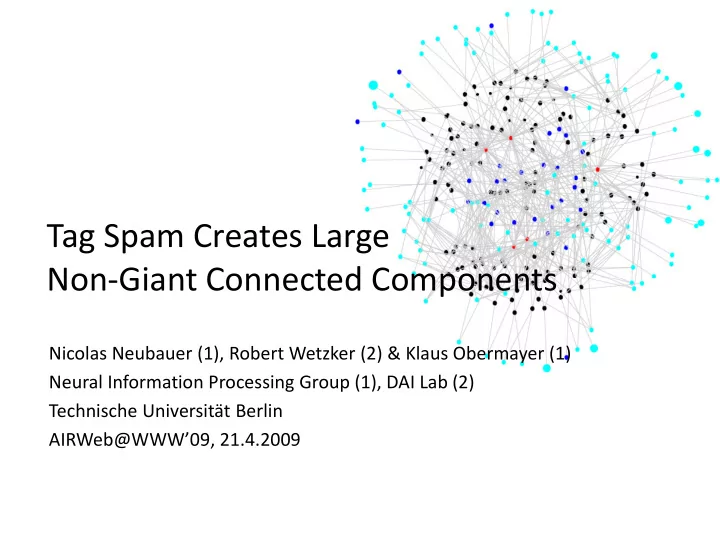

Tag Spam Creates Large Non-Giant Connected Components Non-Giant Connected Components Nicolas Neubauer (1), Robert Wetzker (2) & Klaus Obermayer (1) Neural Information Processing Group (1), DAI Lab (2) Technische Universität Berlin AIRWeb@WWW’09, 21.4.2009
Overview 1. Spam in Social Bookmarking Systems 2. Hyperincident Connected Components 3. Document/User and Tag/User Graphs 4. Conclusions
Social Tagging
Edges: Top 2000 similarities between top 800 documents (no spam) - Bibsonomy
Some tag spam targets search engines • Top entry for a given tag might indicate relevance • Other tag spam targets users • Sites with certain tags might lure users into visiting them • Spammers behave so radically different it shows in the resulting • network structures Edges: Top 2000 similarities between top 800 documents (spam) - Bibsonomy
Overview 1. Spam in Social Bookmarking Systems 2. Hyperincident Connected Components 3. Document/User and Tag/User Graphs 4. Conclusions
Hyperincident Connectivity Tagging data can be interpreted as a hypergraph, defined by hyperedges • (d,u,t) for a document d being tagged with tag t by a user u Two edges are incident if they share a node (i.e., d, u, or t) • – In all examined datasets, everything was basically connected to everything Definition: Two edges are 2-hyperincident if they share at least two nodes • 2-hyperincident connected components: 2-hyperincident connected components: • Components of edges between paths of 2-hyperincident edges exist Blue, dotted lines indicate incident edges Blue, dotted lines indicate 2-hyperincident edges
Expanding 2-hyperincident edges around a user Starting from a legitimate user, we had to stop at a limit of discovered • nodes (here: 2000) Starting from spam users, we often found closed sets of connected nodes • We did not find such components for legitimate users •
Distribution of Component Sizes x=number of components of size y (log/log) Neubauer&Obermayer: Hyperincident Connected Components of Tagging Networks, HyperText 2009, in press
Distribution of Large Components‘ Sizes x = rank of component, y = number of edges in component
Spam Detection Users in nlc/gcc are likely to be • spammers/non-spammers Are spammers/non-spammers also likely • to live in nlc/gcc? Yes • although many users from both classes – do neither. do neither. Distribution of users over components Simple classification heuristic: • If user is only in nlc-> spam = 1 – If user is only in gcc -> spam = 0 – otherwise-> spam = 0.5 – Note that users can be in more than one – component Area under ROC curve (AUC - balanced • accuracy) of .73 ROC curve of simple classifier
Largest and Next-largest 2-HCC for one Month of Delicious Tags
Overview 1. Spam in Social Bookmarking Systems 2. Hyperincident Connected Components 3. Document/User and Tag/User Graphs 4. Conclusions
Doubting Hyper-Incident Connectivity “Nice result, but probably mostly based on documents” • Short story: Right. • – Long story: Tags do have a bit of influence here. Question: What happens if we examine connectivity on the Question: What happens if we examine connectivity on the • document/user graph, ie edges=(d,u) for (d,u,t) in hypergraphs? – And what happens if we do the same for the tag/user graph?
Connectivity Structure (Bibsonomy) We see a the distribution of component sizes in the user/document graph • closely resembles the one found in the entire hypergraph The tag/document graph is mostly connected •
User Distribution Accordingly, membership information on the user/document graph is • comparably informative, while the tag/document graph is useless
Spam Detection New spam detection experiments: applied above heuristic on • document/user graph (red) compared to original approach (black) • new heuristic (blue): • new maximum spam score for users being in nlc in both graphs also examined effect of #documents/user • ROC curves for all three heuristics Results: Hypergraph and document/user graph • connectivity provide similar, but sometimes complementary information Entire approach works better when users • have more documents AUC values
Overview 1. Spam in Social Bookmarking Systems 2. Hyperincident Connected Components 3. Document/User and Tag/User Graphs 4. Conclusions
Final Results & Discussion Requirements Feature extraction on Previous Labels resources or references Content analysis X X Reference analysis X X User Similarity X Structural Analysis Accuracy decreases, but so do domain dependence and • requirements on available information Addition to other, more specialized approaches • Stand-alone baseline when more specialized approaches • are not available Although a large part of connectivity is related to • documents, tags do play a subtle role. Next : Exploring temporal evolution & even stricter • notions of connectivity
Recommend
More recommend